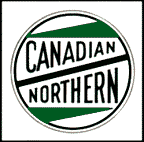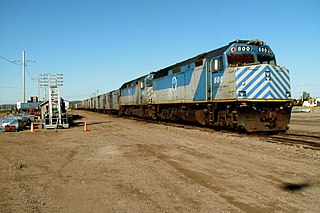
The Ontario Northland Railway is a Canadian railway operated by the Ontario Northland Transportation Commission, a provincial Crown agency of the government of Ontario.

Westport is a village in Eastern Ontario, Canada. It lies at the west end of Upper Rideau Lake, at the head of the navigable Rideau Canal system, 100 km (62 mi) southwest of Ottawa.

The Grand Trunk Railway was a railway system that operated in the Canadian provinces of Quebec and Ontario and in the American states of Connecticut, Maine, Michigan, Massachusetts, New Hampshire, and Vermont. The railway was operated from headquarters in Montreal, Quebec, with corporate headquarters in London, United Kingdom. It cost an estimated $160 million to build. The Grand Trunk, its subsidiaries, and the Canadian Government Railways were precursors of today's Canadian National Railway.

The Canadian Northern Railway (CNoR) was a historic Canadian transcontinental railway. At its 1923 merger into the Canadian National Railway, the CNoR owned a main line between Quebec City and Vancouver via Ottawa, Winnipeg, and Edmonton.

The Algoma Central Railway is a railway in Northern Ontario, Canada, that operates between Sault Ste. Marie and Hearst. It used to have a branch line to Wawa. The area served by the railway is sparsely populated, with few roads.

The St. Lawrence and Atlantic Railroad, known as St-Laurent et Atlantique Quebec in Canada, is a short-line railway operating between Portland, Maine, on the Atlantic Ocean, and Montreal, Quebec, on the St. Lawrence River. It crosses the Canada–US border at Norton, Vermont, and Stanhope, Quebec, and is owned by short-line operator Genesee & Wyoming.
The Ontario and Quebec Railway (O&Q) was a railway located in southern and eastern Ontario, Canada. It was initially chartered in March 1881 by managers of the Canadian Pacific Railway to run between Toronto and Perth, where it would connect, via a short branch line, to the CPR-controlled Brockville and Ottawa Railway. Construction began in 1882, and the line was completed in August 1884.

The Toronto, Hamilton and Buffalo Railway was a railway based in Hamilton that ran in Southern Ontario from 1892 to 1987. It never reached the other two cities in its name although it had branch lines extending to Dunnville and Port Maitland.
The Buffalo and Niagara Falls Railroad was a part of the New York Central Railroad system, connecting Buffalo, New York to Niagara Falls. It is still used by CSX for freight and Amtrak for passenger service.

Tshiuetin Rail Transportation Inc. is a rail company that owns and operates a 217-kilometre (135 mi) Canadian regional railway that stretches through the wilderness of western Labrador and northeastern Quebec. It connects Emeril, Labrador with Schefferville, Quebec on the interprovincial boundary. The company also operates a 356-kilometre (221 mi) railway that connects Sept-Îles, Quebec to Emeril. The company is the first railway in North America owned and operated by Indigenous peoples, specifically by the Innu Nation of Matimekush-Lac John, the Naskapi Nation of Kawawachikamach, and the Innu Takuaikan Uashat Mak Mani-Utenam.
The Ottawa, Arnprior and Parry Sound Railway, or OA&PS, is a historic railway that operated in central and eastern Ontario, Canada from 1897 until 1959. It was, for a time, the busiest railway route in Canada, carrying both timber and wood products from today's Algonquin Provincial Park areas, as well as up to 40% of the grain traffic from the Canadian west from Depot Harbour at Parry Sound through to the St. Lawrence River valley.

The Quebec City–Windsor Corridor, also known as simply the Corridor, is a Via Rail passenger train service in the Canadian provinces of Quebec and Ontario. The Corridor service area has the heaviest passenger train frequency in Canada and contributes 67% of Via's revenue.
The London and Lake Erie Railway and Transportation Company is a defunct Interurban railway that operated in Ontario, Canada from 1902 to 1918. Originally chartered as the South Western Traction Company, the line was renamed the London and Lake Erie Railway in 1909. Throughout its short life, the line was always referred to locally as "The Traction Line".
Burnbrae Farms is a Canadian producer and processor of eggs, supplying grocery store chains, the food service industry, large bakeries and industrial customers. The company has farms in Ontario, Quebec and Manitoba, grading stations across the country and processing operations in Quebec, Ontario and Manitoba.

The Brockville and Ottawa Railway (B&O) was an early railway in Upper Canada, today's Ontario. It ran north from the town of Brockville on the Saint Lawrence River to Sand Point on the Ottawa River. It was built primarily to serve the timber trade on the Ottawa Valley, shortcutting routes that led into the city of Ottawa, further downstream. The first railway tunnel in Canada, the Brockville Tunnel, was dug in order to allow the B&O to reach the port lands on the south side of the city, which sits on a bluff.
King's Highway 29, commonly referred to as Highway 29, was a provincially maintained highway in the Canadian province of Ontario. The 52.29-kilometre (32.49 mi) route connected Highway 2 in downtown Brockville with Highway 15 south of Smiths Falls. Between those larger settlements, it provided access to the communities of Forthton, Addison, Frankville, Toledo and Newbliss.
The Carillon and Grenville Railway (CAGR) was a 5 ft 6 in broad gauge portage railway in Quebec, running approximately 12 miles (19 km) between the towns of Carillon and Grenville on the north bank of the Ottawa River. It provided a through-route from Ottawa to Montreal via steamships on either side of the Long Sault Rapids. It was one of Canada's earliest railways, opened in 1854, and was the last operational broad gauge railway in Canada when it closed in 1910.
The Glengarry and Stormont Railway (G&SR) was a short line railway running from the town of Cornwall in eastern Ontario to connect to the Canadian Pacific Railway's (CP) Ontario and Quebec Railway (O&Q) mainline just inside the Quebec border, a total distance of about 45 kilometres (28 mi). The name refers to the counties it passed through, today amalgamated as Stormont, Dundas and Glengarry.

The Lake Erie and Northern Railway was an interurban electric railway which operated in the Grand River Valley in Ontario, Canada. The railway owned and operated a north–south mainline which ran from Galt in the north to Port Dover on the shore of Lake Erie in the south. Along the way, it ran through rural areas of Waterloo County, Brant County, and Norfolk County, as well as the city of Brantford, where it had an interchange with the Brantford and Hamilton Electric Railway. Construction on the mainline began in 1913. The railway began operations in 1916 as a subsidiary of the Canadian Pacific Railway (CPR), which had purchased the line before construction had finished. In 1931, it was consolidated with the Grand River Railway under a single CPR subsidiary, the Canadian Pacific Electric Lines (CPEL), which managed both interurban railways, though they continued to exist as legally separate entities. Passenger service was discontinued in 1955 but electric freight operations continued until 1961, when the LE&N's electric locomotives were replaced by diesel CPR locomotives and the line was de-electrified. In the same year, service on the mainline from Simcoe to Port Dover was discontinued, but the remainder continued to operate as a branchline which as early as 1975 was known as the CP Simcoe Subdivision. The remainder of the line was officially abandoned in the early 1990s, ending almost seventy-five years of operation.











